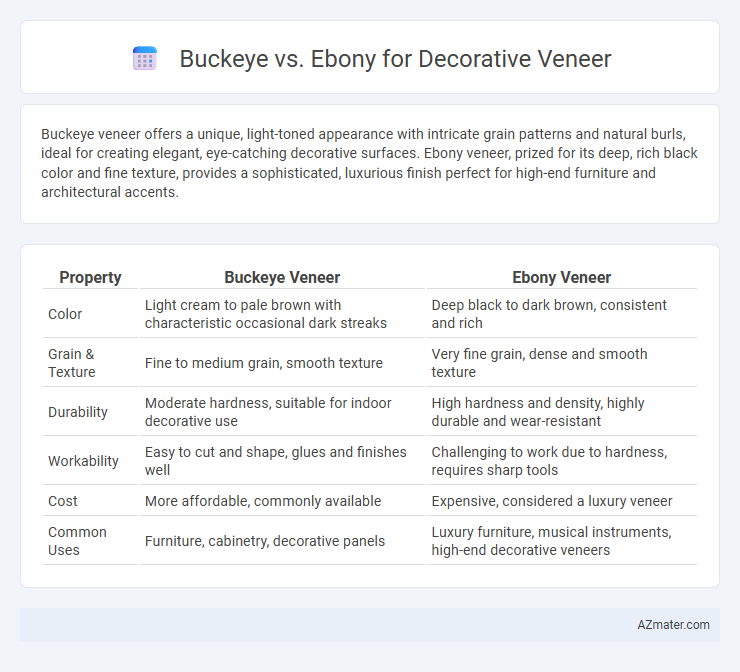Buckeye veneer offers a unique, light-toned appearance with intricate grain patterns and natural burls, ideal for creating elegant, eye-catching decorative surfaces. Ebony veneer, prized for its deep, rich black color and fine texture, provides a sophisticated, luxurious finish perfect for high-end furniture and architectural accents.
Table of Comparison
| Property | Buckeye Veneer | Ebony Veneer |
|---|---|---|
| Color | Light cream to pale brown with characteristic occasional dark streaks | Deep black to dark brown, consistent and rich |
| Grain & Texture | Fine to medium grain, smooth texture | Very fine grain, dense and smooth texture |
| Durability | Moderate hardness, suitable for indoor decorative use | High hardness and density, highly durable and wear-resistant |
| Workability | Easy to cut and shape, glues and finishes well | Challenging to work due to hardness, requires sharp tools |
| Cost | More affordable, commonly available | Expensive, considered a luxury veneer |
| Common Uses | Furniture, cabinetry, decorative panels | Luxury furniture, musical instruments, high-end decorative veneers |
Introduction to Decorative Veneers
Buckeye and Ebony are popular choices for decorative veneers due to their distinct visual appeal and durability. Buckeye veneer features a unique, swirling pattern with a light cream to tan color that enhances interior design with a warm, natural look. Ebony veneer is prized for its deep, rich black tone and fine grain, offering a luxurious, high-contrast aesthetic ideal for modern and classic applications.
What is Buckeye Veneer?
Buckeye veneer is a decorative wood veneer derived from the Buckeye tree (Aesculus glabra), valued for its unique, swirling grain patterns and light to medium brown color with occasional darker streaks. This veneer offers versatility for interior design applications, including furniture, cabinetry, and paneling, providing a visually striking yet subtle natural aesthetic. Compared to ebony, which is much darker and denser, Buckeye veneer is lighter and more affordable, making it a popular choice for creating intricate, textured surfaces without the high cost or heaviness of ebony.
What is Ebony Veneer?
Ebony veneer is a premium wood veneer derived primarily from species in the Diospyros genus, known for its deep, rich black color and fine texture, making it highly sought after for luxury decorative applications. Its density and natural luster provide a striking contrast in cabinetry, furniture, and architectural paneling compared to lighter veneers like Buckeye, which features swirling, burl patterns and a warm, golden hue. The durability and resistance to wear of ebony veneer ensure long-lasting aesthetic appeal in high-end interior design projects.
Visual Characteristics: Buckeye vs Ebony
Buckeye veneer features a light tan to creamy white base with intricate, swirling grain patterns and distinctive burl clusters, creating a striking, rustic appearance. Ebony veneer is known for its deep, rich black color with subtle, fine grain lines, offering a smooth, luxurious, and highly polished finish. The contrasting light tones and textured complexity of Buckeye make it ideal for bold, natural aesthetics, while Ebony's sleek darkness suits modern, elegant interiors.
Durability and Strength Comparison
Buckeye veneer is known for its excellent hardness and resistance to wear, making it highly durable for decorative applications. Ebony veneer offers superior density and strength, providing increased impact resistance and a longer lifespan in high-traffic environments. Both materials possess notable toughness, but Ebony's higher Janka hardness rating typically results in greater overall strength and durability compared to Buckeye.
Cost Differences Between Buckeye and Ebony
Buckeye veneer typically costs significantly less than Ebony due to its abundance and faster growth rate, making it a budget-friendly option for decorative applications. Ebony, known for its dense, dark, and highly durable wood, commands a premium price influenced by its rarity and slower harvest cycles. The cost disparity between Buckeye and Ebony veneers can vary widely, with Ebony often priced multiple times higher per square foot, impacting overall project budgets and material selection decisions.
Sustainability and Sourcing
Buckeye veneer, harvested from sustainable North American sources, offers renewable qualities with fast-growing trees and responsible forestry management, reducing environmental impact. Ebony veneer, sourced primarily from endangered tropical species, faces significant sustainability challenges due to overharvesting and illegal logging, triggering strict trade regulations and certifications like CITES. Choosing Buckeye for decorative veneers supports eco-friendly sourcing and minimizes deforestation risks compared to the limited and often unsustainable availability of Ebony.
Popular Uses in Interior Design
Buckeye veneer is prized for its striking, irregular grain patterns and pale background, making it ideal for bold, artistic interior applications such as feature walls and custom furniture. Ebony veneer offers a deep, rich black tone with fine, consistent texture, preferred for luxury accents like cabinetry, high-end flooring, and sleek modern paneling. Both veneers are durable and visually impactful, frequently used to create contrast and add sophistication in commercial and residential interior design projects.
Maintenance and Longevity
Buckeye veneer offers moderate maintenance with regular sealing to prevent moisture damage, displaying good durability for indoor applications but less resistance to scratches than Ebony. Ebony veneer stands out for its exceptional hardness and dense grain, requiring minimal upkeep while providing long-lasting beauty in high-traffic areas. Both veneers benefit from dusting and careful cleaning, but Ebony's superior resistance to wear enhances its longevity significantly compared to Buckeye.
Choosing the Right Veneer for Your Project
Buckeye veneer offers a distinctive light brown hue with subtle burl patterns that enhance interior spaces with warmth and elegance, making it ideal for traditional or rustic designs. Ebony veneer provides a rich, dark, and consistent grain pattern that creates striking contrasts and sophisticated aesthetics, perfect for modern or high-end applications. Selecting between Buckeye and Ebony veneers depends on the desired visual impact, durability requirements, and the overall style of your project to achieve optimal decorative results.

Infographic: Buckeye vs Ebony for Decorative Veneer
 azmater.com
azmater.com